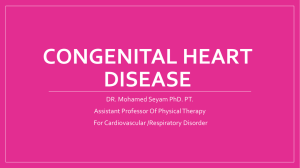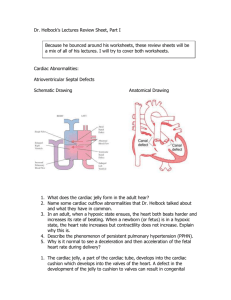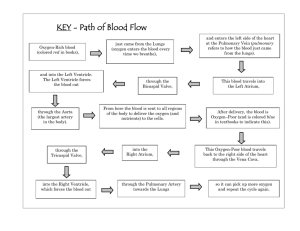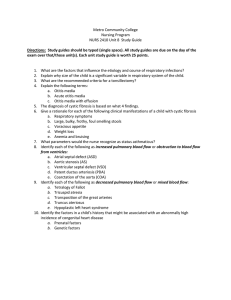Presentation of Congenital Heart Disease in the Neonate and
advertisement
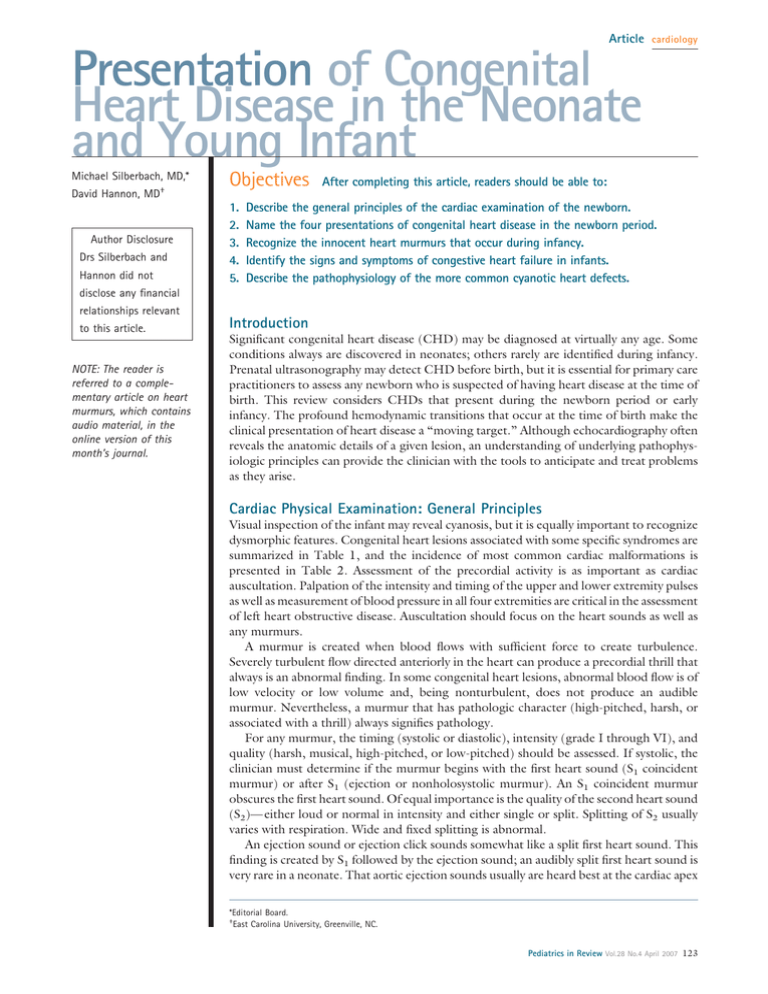
Article cardiology Presentation of Congenital Heart Disease in the Neonate and Young Infant Michael Silberbach, MD,* David Hannon, MD† Author Disclosure Drs Silberbach and Hannon did not Objectives 1. 2. 3. 4. 5. After completing this article, readers should be able to: Describe the general principles of the cardiac examination of the newborn. Name the four presentations of congenital heart disease in the newborn period. Recognize the innocent heart murmurs that occur during infancy. Identify the signs and symptoms of congestive heart failure in infants. Describe the pathophysiology of the more common cyanotic heart defects. disclose any financial relationships relevant to this article. NOTE: The reader is referred to a complementary article on heart murmurs, which contains audio material, in the online version of this month’s journal. Introduction Significant congenital heart disease (CHD) may be diagnosed at virtually any age. Some conditions always are discovered in neonates; others rarely are identified during infancy. Prenatal ultrasonography may detect CHD before birth, but it is essential for primary care practitioners to assess any newborn who is suspected of having heart disease at the time of birth. This review considers CHDs that present during the newborn period or early infancy. The profound hemodynamic transitions that occur at the time of birth make the clinical presentation of heart disease a “moving target.” Although echocardiography often reveals the anatomic details of a given lesion, an understanding of underlying pathophysiologic principles can provide the clinician with the tools to anticipate and treat problems as they arise. Cardiac Physical Examination: General Principles Visual inspection of the infant may reveal cyanosis, but it is equally important to recognize dysmorphic features. Congenital heart lesions associated with some specific syndromes are summarized in Table 1, and the incidence of most common cardiac malformations is presented in Table 2. Assessment of the precordial activity is as important as cardiac auscultation. Palpation of the intensity and timing of the upper and lower extremity pulses as well as measurement of blood pressure in all four extremities are critical in the assessment of left heart obstructive disease. Auscultation should focus on the heart sounds as well as any murmurs. A murmur is created when blood flows with sufficient force to create turbulence. Severely turbulent flow directed anteriorly in the heart can produce a precordial thrill that always is an abnormal finding. In some congenital heart lesions, abnormal blood flow is of low velocity or low volume and, being nonturbulent, does not produce an audible murmur. Nevertheless, a murmur that has pathologic character (high-pitched, harsh, or associated with a thrill) always signifies pathology. For any murmur, the timing (systolic or diastolic), intensity (grade I through VI), and quality (harsh, musical, high-pitched, or low-pitched) should be assessed. If systolic, the clinician must determine if the murmur begins with the first heart sound (S1 coincident murmur) or after S1 (ejection or nonholosystolic murmur). An S1 coincident murmur obscures the first heart sound. Of equal importance is the quality of the second heart sound (S2)— either loud or normal in intensity and either single or split. Splitting of S2 usually varies with respiration. Wide and fixed splitting is abnormal. An ejection sound or ejection click sounds somewhat like a split first heart sound. This finding is created by S1 followed by the ejection sound; an audibly split first heart sound is very rare in a neonate. That aortic ejection sounds usually are heard best at the cardiac apex *Editorial Board. † East Carolina University, Greenville, NC. Pediatrics in Review Vol.28 No.4 April 2007 123 cardiology congenital heart disease Mendelian Gene Syndromes Associated with Congenital Heart Anomalies* Table 1. Frequency of Cardiac Anomalies† Etiologic Syndrome All (%) Distinctive or Most Common Autosomal Dominant Adams-Oliver syndrome 20 Alagille syndrome 95 Char syndrome Cornelia de Lange syndrome Holt-Oram syndrome 60 25 80 Neurofibromatosis 2 Noonan syndrome 85 Rubinstein-Taybi syndrome 35 Williams syndrome 60 Autosomal Recessive Ellis-van Creveld syndrome 60 Fryns syndrome Keutel syndrome Left-sided obstruction (eg, COA, parachute MVP), TOF (P)PS, TOF/TOF with PA, ASD, VSD PDA VSD, ASD, PS, TOF ASD ⴞ other CVM, VSD, TA, TOF, PAPVC, conduction defect PSV, ASV, COA, HCM Scalp cutis aplasia, terminal transverse limb defects AVSD, common atrium, ASD primum ASD, VSD, conotruncal (P)PS Bile duct paucity, chronic cholestasis, butterfly vertebrae, posterior embryotoxon Anomalies on fifth finger, supernumerary nipple Upper limb deficiency, GI anomalies Upper limb malformations Café au lait macules, optic glioma, scoliosis, pseudarthrosis, neurofibromas PSV, ASD, AVSD partial, COA, Short, webbed neck; pectus deformity; HCM cryptorchidism PDA, ASD, VSD, left-sided Broad thumbs and great toes obstruction (eg, COA, HLHS) SVAS, PS, other left-sided Hypercalcemia, hypodontia, hypoplastic nails obstructions (eg, ASV, MS, COA) 45 ASD, VSD, complete AVSD, TAPVC Short limbs, polydactyly, hypoplastic nails, dental anomalies Diaphragmatic hernia, distal digital hypoplasia Short digits, mixed hearing loss, cartilage calcification Two- to three-toe syndactyly, cleft palate, lung anomalies, genital anomalies 25 ASD; VSD; rare, variable cardiomyopathy Macrosomia, cleft palate, supernumerary nipples, hernias, hypospadias, poly/syndactyly 75 ASD, HCM Sparse, curly hair; low, rotated ears; hyperkeratosis 80 Conotruncal/arch, assorted CVMs MVP, AV, thickening HCM, arrhythmia (atrial tachycardia) COA; IAA, A right; double, cervical aortic arch TOF, DORV, AVSD Coloboma, choanal atresia, genital anomalies, ear anomalies Skin/joint laxity, fine/curly hair, deep palm creases, ulnar deviation, papillomata 50 70 Smith-Lemli-Opitz syndrome X-linked Recessive Simpson-Golabi-Behmel syndrome Suspected Gene Etiology Cardio-facio-cutaneous syndrome Hall-Hittner syndrome (CHARGE association) Costello syndrome Distinguishing Features 60 PHACES syndrome 100 Ritscher-Schinzel syndrome (3C) 100 Posterior fossa malformations, hemangiomas, eye anomalies Posterior fossa malformations, cleft palate, coloboma ASD⫽atrial septal defect, ASV⫽aortic stenosis, valvar, AV⫽atrioventricular valve, AVSD⫽atrioventricular septal defect, COA⫽coarctation, CVM⫽cardiovascular malformations, DORV⫽double-outlet right ventricle, GI⫽gastrointestinal, HCM⫽hypertrophic cardiomyopathy, HLHS⫽hypoplastic left heart syndrome, IAA, A/B⫽interrupted aortic arch, type A or B, MS⫽mitral stenosis, MVP⫽mitral valve prolapse, PAPVC⫽partial anomalous pulmonary venous connection, PDA⫽patent ductus arteriosus, PS⫽pulmonic stenosis, (P)PS⫽(peripheral) pulmonic stenosis, PSV⫽pulmonary stenosis (valvular), SVAS⫽supraventricular aortic stenosis, TA⫽truncus arteriosus, TAPVC⫽total anomalous pulmonary venous connection, TOF⫽tetralogy of Fallot, TOF with PA⫽tetralogy of Fallot with pulmonary atresia, VSD⫽ventricular septal defect *Modified from Lin AE, Holly HA. Genetic epidemiology of cardiovascular malformations. Progr Pediatr Cardiol. 2005;20:113–126 with permission from Elsevier. † Frequency figures rounded. 124 Pediatrics in Review Vol.28 No.4 April 2007 cardiology Table 2. congenital heart disease Incidence of Most Common Cardiac Malformations* Prevalence (per 10,000 Births) Malformation Heterotaxy, L-TGA Outflow tract defects, total Tetralogy of Fallot D-TGA Double-outlet right ventricle Truncus arteriosus Atrioventricular septal defect With Down syndrome Without Down syndrome Ebstein anomaly Total APVC Right-sided obstruction Peripheral pulmonic stenosis Pulmonic stenosis, atresia Pulmonic atresia/intact septum Tricuspid atresia Left-sided obstruction Coarctation of the aorta Hypoplastic left heart Aortic valve stenosis Aortic arch atresia or hypoplasia Septal defects Ventricular septal defect Atrial septal defect Patent ductus arteriosus Other major heart defects Total Metropolitan Atlanta Congenital Defect Program, 1995-1997 Baltimore-Washington Infant Study, 1981–1989 1.6 1.4 4.7 2.4 2.2 0.6 3.3 2.3 0.7 0.5 2.4 1 0.6 0.6 2.3 1 0.6 0.7 7 5.9 0.6 0.3 Not available 5.4 0.6 0.4 3.5 2.1 0.8 0.6 1.4 1.8 0.8 Not available 24.9 10 8.1 9.7 90.2 11.2 3.2 0.9 48.4 APVC⫽anomalous pulmonary venous connection, TGA⫽transposition of the great arteries. *Reprinted from Lin AE, Holly HA. Genetic epidemiology of cardiovascular malformations. Progr Pediatr Cardiol. 2005;20:113–126 with permission from Elsevier. rather than at the upper right sternal edge is underappreciated. Normal splitting of S1 can be appreciated easily in a calm adolescent and is reminiscent of the aortic ejection click. Thus, practicing auscultation of the split S1 in an older individual may provide the novice an appreciation for the sound of the ejection click. If S1 clearly is audible, the murmur is likely to be an ejection murmur produced by stenosis of the aortic or pulmonary valve or by increased flow in a great artery. Nonholosystolic murmurs are ejection murmurs because they are related to the vibration of blood as it is ejected from the great arteries. However, innocent murmurs are not harsh or high-pitched (because normal blood flow is not turbulent or of high velocity); they are never associated with a precordial thrill, a significant ventricular lift or tap, or an abnormal S2. If S1 is obscured, the murmur probably is S1 coincident or holosystolic. S1 coincident murmurs never are normal. Accurate estimation of the precordial activity as well as the intensity of the second heart sound is not difficult with practice. Documentation of normal precordial activity, second heart sound, and upper and lower extremity pulses should be routine. Clinical Presentations Most infants who ultimately require the care of a pediatric cardiologist have one of four presentations: 1) asymptomatic murmur, 2) cyanosis (often without a murmur), 3) gradually progressing symptoms of heart failure, or 4) catastrophic heart failure and shock. The latter two presentations almost always occur after discharge from the newborn nursery. Pediatrics in Review Vol.28 No.4 April 2007 125 cardiology congenital heart disease The Asymptomatic Newborn Who Has a Murmur A transient systolic murmur heard in the first hours after birth can be caused by turbulent flow through a closing ductus arteriosus. Alternatively, echocardiography may demonstrate high-velocity tricuspid valve regurgitation that lessens over hours as the right ventricular pressure diminishes with the normal fall in pulmonary vascular resistance. The normally high right ventricular pressure in the immediate newborn period makes ventricular septal defect a less likely cause. Murmurs in asymptomatic neonates can be caused by regurgitant valves (mitral or tricuspid) or by lesions producing turbulence in a great artery (pulmonic stenosis, aortic stenosis, nonphysiologic peripheral pulmonary stenosis, supravalvular aortic stenosis). Combinations of these lesions also exist. Affected infants usually are asymptomatic unless there is critical stenosis of the pulmonary or aortic valve. Tetralogy of Fallot is an example of such a disease. Many infants afflicted with tetralogy present with a murmur of increased flow through a relatively small right ventricular outflow tract. Although cyanosis eventually occurs over the course of months, infants who have acyanotic or “pink” tetralogy may have room air oximetry values of 100%. In fact, the initial signs in such infants likely relate to heart failure due to left ventricular volume load. If a systolic murmur that obscures S1 occurs in an asymptomatic infant, it is pathologic and probably caused by a ventricular septal defect or atrioventricular valve regurgitation. Complete endocardial cushion defects (complete atrioventricular septal defects) also have S1 coincident murmurs. It is important to remember that a ventricular septal defect (isolated or as part of an endocardial cushion defect) may have no murmur if persistence of high pulmonary vascular resistance causes the right ventricular pressure to remain elevated. More typically, the normal decrease in the pulmonary vascular resistance over the first 6 postnatal weeks is associated with increasing intensity of a murmur. If high pulmonary vascular resistance persists (as often occurs in babies who have trisomy 21), not only is the murmur difficult to hear, but the second heart sound is loud. In these cases, precordial palpation reveals a prominent right ventricular lift or tap. Systolic murmurs that start after S1 may be innocent or pathologic. Aortic valve stenosis and pulmonary valve stenosis often are associated with an ejection click at the onset of the murmur. The presence of an ejection click that has a harsh quality, grade III or higher intensity, or a very high pitch suggests pathologic stenosis as the cause of the murmur. 126 Pediatrics in Review Vol.28 No.4 April 2007 Infants Who Have Cyanotic CHD The mnemonic of the five “Ts” (transposition, tetralogy of Fallot, tricuspid atresia, total anomalous pulmonary venous connection, truncus arteriosus) may be useful in recalling the names of the classic cyanotic CHDs, but it can be misleading because the clinical presentations of these lesions usually differ markedly and often are not characterized by the visual appreciation of cyanosis. Of these five lesions, only transposition of the great arteries is associated with severe cyanosis in the first hours after birth. Severe cyanosis occurs early in infants who have transposition because the oxygenated pulmonary venous blood is unable to reach the systemic circulation. Deoxygenated systemic venous blood coursing through the right ventricle and aorta cannot reach the pulmonary artery, and oxygenated pulmonary venous blood returning to the left ventricle and flowing into the pulmonary artery fails to reach the aorta. Spontaneous closure of the ductus in the neonate prevents this essential bidirectional blood flow. If the ductus arteriosus is patent, oxygenated and unoxygenated blood can mix. Mixing of systemic and pulmonary venous blood also can occur at the atrial level through the foramen ovale. Thus, for infants who have transposition of the great arteries, prostaglandin E1 (alprostadil) infusion is employed to maintain ductal patency and a Rashkind balloon atrial septostomy performed to ensure an atrial-level communication prior to anatomic correction (the so-called arterial switch procedure) in the operating room. The other “Ts” usually do not present with severe cyanosis. Total anomalous pulmonary venous connection, tricuspid atresia, and truncus arteriosus are different forms of admixure lesions that typically have increased pulmonary blood flow. In these cases, pulmonary venous blood and desaturated systemic venous blood mix at the level of the atrium, ventricle, or great artery. If the pulmonary blood flow is unrestricted, the oxygen saturation of blood delivered to the systemic circulation can be very high. Patients who have admixture lesions and increased pulmonary blood flow may have room air oxygen saturations greater than 90%. Cyanosis is observable only if there is decreased pulmonary blood flow from severe pulmonary stenosis, inadequate right ventricular capacity, or persistently high pulmonary vascular resistance that exceeds the systemic vascular resistance. Conversely, pulmonary valve atresia (with or without a ventricular septal defect) can present with early severe cyanosis once the ductus arteriosus starts to close. The other lesion that presents with critical cyanosis (sometimes even in the delivery room) is severe Ebstein mal- cardiology formation. In this disease, apical displacement of the tricuspid valve limits the capacity of the right ventricle to accept blood. Right-to-left shunting of blood through a patent foramen ovale or atrial septal defect results in severely decreased pulmonary blood flow. In all three cases, prostaglandin infusion can maintain ductal patency, which permits life-sustaining pulmonary blood flow prior to either surgical placement of an aortopulmonary shunt (eg, modified Blalock-Taussig shunt) or complete repair. The very young newborn who exhibits severe cyanosis, therefore, is likely to have either transposition of the great arteries, pulmonary atresia, or Ebstein malformation. Evidence of normal or high pulmonary blood flow on the chest radiograph (prominent pulmonary vascular congenital heart disease serving essentially as a vestibule that conducts the blood into the pulmonary artery. A ventricular septal defect allows blood flow from the left ventricle to pass through the small right ventricle into the pulmonary artery. If the ventricular septal defect is large, cyanosis is minimal. If the ventricular septal defect or the pulmonary valve annulus is small, a loud murmur may be present. Cyanosis still may not be clinically apparent. Affected infants often are believed to have a simple ventricular septal defect on the basis of auscultation. Only if there is a small or absent ventricular septal defect or critical pulmonary stenosis is there clinical evidence of cyanosis. The same principle applies to other forms of single ventricle, such as double-inlet left ventricle and complex heterotaxy (asplenia and polysplenia syndromes). If there is a functional single ventricle, the degree of pulmonary stenosis (and, hence, the volume of pulmonary blood flow) determines the degree of cyanosis. Hypoplastic left heart syndrome is similar to other single ventricle “mixing lesions.” However, the lack of aortic development makes affected patients more appropriate for discussion in the section under catastrophic heart failure. All single-ventricle lesions require staged surgical procedures designed to route the systemic venous blood directly into the pulmonary arteries (the bidirectional Glenn and Fontan operations). In total anomalous pulmonary venous connection, red and blue blood are mixed in either the systemic veins returning to the right atrium or within the right atrium itself. A patent foramen or atrial septal defect allows the blood to enter the left heart. Because the volume and direction of an atrial-level shunt is determined by the relative compliance of the right and left heart, the highly compliant right ventricle accepts considerably more blood than the left ventricle. Indeed, when the anomalous pulmonary vein connection is above the diaphragm (connected to the innominate vein, superior vena cava, coronary sinus, or right atrium), there is a significant volume load on the right side of the heart, increased pulmonary blood flow, and minimal cyanosis. The clinical presentations of affected patients may be difficult to distinguish from that of an infant who has a simple atrial septal defect: a palpable sternal lift, wide and fixed splitting of S2 (due to the right ventricular volume overload), a pulmonary flow murmur, a tricuspid valve diastolic flow The very young newborn who exhibits severe cyanosis . . . is likely to have either transposition of the great arteries, pulmonary atresia, or Ebstein malformation. markings) usually excludes the diagnosis of pulmonary atresia and Ebstein malformation and points toward transposition. Murmurs can be subtle (or absent) in neonates who have any of the previously noted cyanotic CHDs. In transposition of the great arteries, the flow from the (blue) right ventricle out the (transposed) aorta or from the (red) left ventricle out the (transposed) pulmonary artery is nonturbulent. In pulmonary atresia, there is no flow across the imperforate pulmonary valve, and the only source of a murmur may be some degree of turbulence through the patent ductus arteriosus. In Ebstein malformation, tricuspid regurgitation can be the source of a murmur. Most commonly, the presence of serious CHD is heralded by the identification of cyanosis in an infant who is not in respiratory distress (“happy cyanosis”). Tricuspid atresia is a relatively common form of “single-ventricle” defect. All of the systemic venous return passes through the foramen ovale to the left atrium and left ventricle, where it mixes with oxygenated pulmonary venous blood entering the left atrium. The large functionally single ventricle conducts blood into both great arteries. Unless there is no restriction to the pulmonary blood flow, the right ventricle is diminutive, Pediatrics in Review Vol.28 No.4 April 2007 127 cardiology congenital heart disease rumble, and tachypnea caused by pulmonary overcirculation or pulmonary edema. The only difference between the physical findings of atrial septal defect and total anomalous pulmonary vein connection is the presence of (often mild) cyanosis. Accordingly, affected infants may not be diagnosed until several months of age. When the pulmonary venous confluence drains below the diaphragm into the liver, the portal system, or the inferior vena cava, the return of pulmonary venous blood to the right atrium commonly is obstructed. Such infants are ill in the newborn nursery and can resemble infants who have severe lung disease. Severe pulmonary edema, pulmonary hypertension, and cyanosis are apparent. Obstructed total anomalous pulmonary venous connection always is in the differential diagnosis of an infant who has clinical pulmonary hypertension (persistent pulmonary hypertension of the newborn). Truncus arteriosus is similar to tetralogy of Fallot inasmuch as a dilated aorta overrides a large ventricular septal defect. However, unlike tetralogy, in truncus arteriosus, a well-developed pulmonary artery system arises directly from the ascending aorta. This trifurcating structure, also called the truncal root, permits the blue and red venous blood to mix in the great artery. Because flow into the pulmonary arteries from the truncal root is unrestricted, affected infants often have minimal cyanosis and no significant murmur. Typically, S2 is very loud due to the anterior position of the truncal (aortic) valve. A marked ventricular lift always is palpable. An ejection click (or multiple clicks) caused by a valve that can have as many as six leaflets often is present. It is common for infants who have truncus arteriosus to present with failure to thrive at several months after birth. The surgical repair of truncus arteriosus resembles that of tetralogy of Fallot. The ventricular septal defect is patched such that the overriding aorta is committed to the left ventricle. A conduit must be placed between the right ventricle and the pulmonary arteries because, unlike the anatomy of tetralogy, there is no pulmonary valve or main pulmonary artery that can be enlarged. One of the key features of the previously described admixture lesions are murmurs caused by stenotic valves, pulmonary vessels, or a pressure-restricted ventricular septal defect. Additionally, the absence of pulmonary stenosis leads to increased pulmonary blood flow and minimal cyanosis. Sometimes transient cyanosis is observed on the first postnatal day. It is common, however, for infants to remain undiagnosed in the nursery unless persistent mild desaturation is recognized by pulse oximetry. Percutaneous pulse oximetry values below 95% 128 Pediatrics in Review Vol.28 No.4 April 2007 never are normal in otherwise healthy-appearing infants after the first 6 postnatal hours. The physical examination may reveal an abnormal ventricular lift in infants who have admixture-type lesions. Auscultatory clues to early diagnosis are a single S2 (truncus arteriosus or tricuspid atresia), a widely split S2 (total anomalous pulmonary venous connection), and an aortic ejection click (truncus arteriosus). Echocardiography confirms the diagnosis. Tetralogy of Fallot was described in the section of asymptomatic infants who have murmurs because infants who have this cardiac malformation usually are acyanotic at birth, but often have systolic murmurs. In cases of tetralogy of Fallot with pulmonary atresia or severe pulmonary stenosis, a murmur may be less obvious, but the cyanosis is more severe and of earlier onset. An exception to this rule is the infant who has tetralogy of Fallot, pulmonary atresia, and multiple aortopulmonary collateral vessels. In these infants, flow to the lungs from multiple vessels arising from the descending aorta may prevent cyanosis from being appreciated. The sound of continuous murmurs throughout the back caused by multiple collateral blood vessels is the hallmark of this disease. Hypercyanotic spells (“tetralogy spells”) are unusual in the newborn period but can occur at any time in infancy in a baby whose tetralogy of Fallot has not been repaired. Rarely, a hypercyanotic spell is the presenting symptom in an affected infant. During a hypercyanotic spell, intense cyanosis develops rapidly. The clinical signs are a marked and sudden diminution of the loudness of the murmur caused by decreased systolic flow through the right ventricular outflow tract; intense cyanosis (the author has seen oximetry readings stay below 20% with excellent plethysmographic waveforms during classic “tetralogy spells”); and a deep, rapid respiratory pattern (hyperpnea). Calming the infant (with or without sedation) may be enough to resolve the spell. However, infants may become obtunded and lose consciousness. Once an infant has developed progressive cyanosis or has evidence of hypercyanotic spells, surgical correction is indicated. Elective repair in the first postnatal year now is the rule, even for infants who do not have cyanosis. CHD With Progressive Heart Failure in Infants Heart failure in infants manifests by a collection of signs that result from excessive pulmonary blood flow or inadequate systemic blood flow. Infants who have large ventricular septal defects, endocardial cushion defects (atrioventricular septal defects), or large persistently patent ducti typically are asymptomatic at the time of birth, but cardiology develop signs and symptoms of excessive pulmonary blood flow and heart failure after the natural fall of the pulmonary vascular resistance. Findings include tachypnea, sweating (especially of the forehead), difficulty feeding, failure to thrive, gallop rhythm, and hepatomegaly. These signs may precede the diagnosis of CHD because the blood flow through large defects may be nonturbulent in the newborn period while the pulmonary resistance is still high. As the signs of heart failure gradually become more apparent, a murmur is detected more easily because a larger volume of blood is passing through the defect. Accumulating evidence suggests that measurement of serum B-type natriuretic peptide (BNP) can help the clinician distinguish between pulmonary or infectious causes of tachypnea and heart failure. The left-to-right shunt through a large ventricular septal defect, atrioventricular septal defect, or patent ductus arteriosus causes pulmonary overcirculation. The resulting excessive pulmonary venous return presents a congenital heart disease infants and children is a rapidly evolving and important field. CHD Presenting as Shock or Catastrophic Heart Failure For infants who have critical coarctation of the aorta, interrupted aortic arch, critical aortic valve stenosis, and hypoplastic left heart syndrome, inadequate left heart development compromises cardiac output. In this situation, the right ventricle maintains the systemic blood flow by ejecting blood through the neonatal patent ductus arteriosus. The admixture of red and blue venous returns occurs in these “left heart” lesions just as in other cyanotic cardiac malformations, but the potential for catastrophic deterioration due to inadequate systemic flow is much greater as the ductus arteriosus undergoes normal spontaneous closure. In left heart lesions, the flow from right ventricle into the lungs typically is unimpaired. The oxygenated blood returning from the lungs is either completely diverted across an atrial-level communication into the right ventricle (in the case of hypoplastic left heart) or partially diverted to the right heart, depending on the filling properties of the left ventricle. In the right atrium, pulmonary venous blood mixes with desaturated systemic venous blood returning from the body, thereby increasing the oxygen saturation of the right heart blood. Consequently, the relatively high saturations of the ductal blood flowing into the aorta minimize the appearance of cyanosis, even though the right ventricle is supplying the entire systemic cardiac output (in hypoplastic left heart or critical aortic stenosis) or the lower body’s blood flow (in coarctation or interrupted aortic arch). In the newborn nursery, the only clues to the presence of these lesions may be a single and loud S2, a marked increase in right ventricular activity on precordial palpation, or a minimally abnormal postductal pulse oximetry reading. Decreased femoral pulses often are not present at this stage because the ductus usually is large. If critical left heart obstruction is suspected, room air pulse oximetry in the lower extremities (postductal saturation) may be helpful. A value above 96% or 97% rules out a completely ductal-dependent left heart obstruction (hypoplastic left heart or interrupted aortic arch). High saturations, however, can occur in the setting of coarctation of the aorta. Others have proposed that postductal Most diseases causing heart failure in infants can be treated surgically as soon as signs develop. volume load to the left ventricle and leads to elevated ventricular filling pressures and pulmonary edema. Thus, the term “congestive heart failure” is not entirely inappropriate in these infants, although the ventricular stroke volume (containing both the pulmonary and systemic blood flow) is supranormal. Along with increased pulmonary blood flow, the increasing metabolic demands of the body may stress the ability of the heart to increase the systemic cardiac output. As a result, just as in adults who have heart failure, there is a marked activation of the so-called neurohormonal axis. Elevations of sympathetic tone, plasma catecholamines, the renin-angiotensin-aldosterone system, cytokines, and other vasoactive molecules provide acute compensation for the failing heart. However, accumulating evidence in both adult and childhood heart failure indicates that chronic neurohormonal activation is deleterious and that treatments that inhibit this activation may be beneficial. Most diseases causing heart failure in infants can be treated surgically as soon as signs develop. The treatment of other forms of chronic heart failure in Pediatrics in Review Vol.28 No.4 April 2007 129 cardiology congenital heart disease percutaneous oxygen saturation should be used routinely to screen for all forms of ductal-dependent cardiac malformations, both left heart obstruction and admixture types. Unfortunately, ductal-dependent left heart lesions often present after discharge from the newborn nursery. Indeed, ductal patency may persist for weeks or, in rare cases, months. The constriction and closure of the ductus arteriosus cause decreased systemic blood flow, oliguria, acidosis, pulmonary edema, and heart failure. As the cardiac output decreases, retrograde blood flow from the ductus into the common coronary artery (ascending aorta) results in decreased right and left coronary artery blood flow, leading to myocardial ischemia, ventricular dysfunction, and death. The clinical presentation of left heart obstructive disease may mimic sepsis; the infant exhibits tachypnea, mottled gray skin, and poor perfusion, with decreased peripheral and central pulses. Critical clues in a 3-weekold infant that should lead to the consideration of a cardiac diagnosis rather than sepsis include the presence of a gallop rhythm and marked hepatomegaly or cardiomegaly. Profound metabolic acidosis with pH values of 7.0 or less are characteristic. A high serum BNP concentration may prove to be a cardiac-specific marker of heart failure in this setting. Fluid resuscitation as well as respiratory and inotropic support are essential treatments for these very sick infants, although systemic blood flow and reversal of shock 130 Pediatrics in Review Vol.28 No.4 April 2007 cannot be achieved until ductus arteriosus patency is re-established with prostaglandin E1 (alprostadil) infusion. If the clinical suspicion of critical coarctation or hypoplastic left heart syndrome is high, prostaglandin infusion should be started prior to echocardiographic confirmation of the diagnosis. Conclusion The spectrum of CHD presenting in the newborn period and early infancy ranges from benign to catastrophic. The only clue available to the clinician that a critical cardiac malformation is present may be a mild decrease in the percutaneous oxygen saturation. For this reason, every infant should have pulse oximetry performed before discharge from the newborn nursery. The newborn physical examination may provide the subtle clues that could be lifesaving. Thus, identification of the rare but critical heart defect in a neonate depends on the perseverance and high index of suspicion by the primary caregiver. Suggested Reading Lin AE, Holly HA. Genetic epidemiology of cardiovascular malformations. Progr Pediatr Cardiol. 2005;20:113–126 Odland HH, Thaulow EM. Heart failure therapy in children. Expert Rev Cardiovasc Ther. 2006;4:33– 40 Savitsky E, Alejos J, Votey S. Emergency department presentations of pediatric congenital heart disease. J Emerg Med. 2003;24: 239 –245 cardiology congenital heart disease PIR Quiz Quiz also available online at www.pedsinreview.org. 1. Which of the following findings on the newborn examination may be normal? A. B. C. D. E. Fixed S2. High-pitched murmur. Obscured S1. Precordial thrill. Systolic ejection murmur. 2. A 2-hour-old infant exhibits severe cyanosis. Of the following, the most likely diagnosis is: A. B. C. D. E. Tetralogy of Fallot. Total anomalous pulmonary venous return. Transposition of the great arteries. Tricuspid atresia. Truncus arteriosus. 3. Among the following clinical findings, the only one that distinguishes atrial septal defect from total anomalous pulmonary venous connection is: A. B. C. D. E. A pulmonary flow murmur. A sternal lift. Cyanosis. Tachypnea. Wide fixed splitting of S2. 4. Among the following, the most common cardiac malformation is: A. B. C. D. E. Coarctation of the aorta. Patent ductus arteriosus. Pulmonic stenosis. Tetralogy of Fallot. Ventricular septal defect. 5. You are teaching medical students about examination of the heart and note that aortic ejection sounds are heard best at the: A. B. C. D. E. Cardiac apex. Left third intercostal space. Sternal notch. Upper left sternal edge. Upper right sternal edge. Pediatrics in Review Vol.28 No.4 April 2007 131
